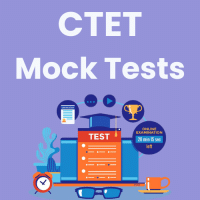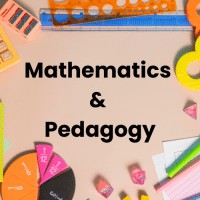CTET & State TET Exam > CTET & State TET Questions > Answer the following questions by selecting t...
Start Learning for Free
Answer the following questions by selecting the most appropriate option.
Q. The philosophy behind the project method is
- a)naturalism
- b)idealism
- c)constructivism
- d)Pragmatism
Correct answer is option 'D'. Can you explain this answer?
Most Upvoted Answer
Answer the following questions by selecting the most appropriate optio...
I think it will be pragmatism, I am trying to share here a little bit concept of pragmatism in education, collected from study.com .
Pragmatism Theory
Pragmatism was a school of philosophy that became popular in the United States in the early twentieth century. This philosophy emphasized that an idea's usefulness or practicality should be the method for measuring the merit of the idea. Today the term "pragmatic" is used to describe things that are realistic and grounded. Instead of focusing on possibilities, this theory states that ideas should be judged on their practical real-world applications.
As educational philosophy began to grow throughout the twentieth century many people applied pragmatism to education. This theory has grown in popularity in the educational field, emphasizing that teaching students practical skills can be helpful to them later in life. Because of this theory many schools have changed the way that they teach and assess students.
Pragmatism in Education
Pragmatism in education states that learning should be focused on life and growth. The topics students study in school should have practical applications to their current or future situations or careers. While topics like math and science can help students in their day-to-day life, proponents of the pragmatism philosophy also argue that other topics should be included in the curriculum to help students grow. Schools should not only teach information, but also help students grow as people.
In recent years more schools have introduced Social Emotional Learning (SEL) curriculum. These lessons are meant to help students deal with difficult real-life situations. They also teach students to handle conflict and to regulate their emotions. Through these lessons, many teachers and administrators hope it will help students not only be more prepared for life but also become better students.
Pragmatic Approach to Learning
The pragmatic approach to learning states that learning should be practical. Education should apply to the real world. Many teachers tackle this by using real-world scenarios that students either will encounter or may have already encountered. It is not enough to simply give students a lecture about climate change. To make this learning more practical, the teacher should have students research how climate change is affecting their students' lives and possible future. They could also look into steps they can take to help deal with the issue of climate change. This would be an authentic application of practical learning.
Teaching students about current issues is a great way to introduce practical learning. Teaching students current social issues does not just teach them about real-world problems, but it can help give them the tools to be more prepared for adult life. These social issues affect them; it is their future that will be impacted by the choices of our elected officials.
Many government or current events teachers have students write to their elected officials urging them to take action on an issue. This gives students one practical tool for real political action. Instead of telling students about the fact that they can contact their elected officials, having them actually take action is a much more active process. Studies have shown that practical, active learning is much more impactful on students. They are more likely to remember what they have learned that way.
Experiential Learning
Experiential learning is another form of pragmatist philosophy in education. According to supporters of experiential learning, students learn through actual experiences, or practice. Instead of learning the ideas behind a topic, students should discover this knowledge through experience. Then, students should put their knowledge and skills into practice.
For example, Ms. Smith is planning a lesson about the Revolutionary War. She usually gives a lecture about the topic, while students copy down notes from her PowerPoint. However, she wants to make her lesson this year much more exciting. She wants students not to just learn about history, but study it the way historians do. She instead finds primary sources, or documents written by people who experienced the events of the Revolutionary War. She plans to give students a two-minute summary of the Revolutionary War. Then she will have students look at the documents themselves to explore the events of the war. She will use guided questions to help students string together the events themselves just like historians do.
some more -
How do teachers apply pragmatism?
Teachers can apply pragmatism by making their learning practical. Any time they teach a topic they should help students understand its real-world applications. They can also have students practice or experience new skills or situations.
What is pragmatism?
Pragmatism is a philosophy of practicality that has been applied to education. According to this philosophy, education should be focused on real-life applications and student growth.
(N.B.- direct collected/ copied from study. com. You make check there for more and get connection between project learnings and pragmatism)
Pragmatism Theory
Pragmatism was a school of philosophy that became popular in the United States in the early twentieth century. This philosophy emphasized that an idea's usefulness or practicality should be the method for measuring the merit of the idea. Today the term "pragmatic" is used to describe things that are realistic and grounded. Instead of focusing on possibilities, this theory states that ideas should be judged on their practical real-world applications.
As educational philosophy began to grow throughout the twentieth century many people applied pragmatism to education. This theory has grown in popularity in the educational field, emphasizing that teaching students practical skills can be helpful to them later in life. Because of this theory many schools have changed the way that they teach and assess students.
Pragmatism in Education
Pragmatism in education states that learning should be focused on life and growth. The topics students study in school should have practical applications to their current or future situations or careers. While topics like math and science can help students in their day-to-day life, proponents of the pragmatism philosophy also argue that other topics should be included in the curriculum to help students grow. Schools should not only teach information, but also help students grow as people.
In recent years more schools have introduced Social Emotional Learning (SEL) curriculum. These lessons are meant to help students deal with difficult real-life situations. They also teach students to handle conflict and to regulate their emotions. Through these lessons, many teachers and administrators hope it will help students not only be more prepared for life but also become better students.
Pragmatic Approach to Learning
The pragmatic approach to learning states that learning should be practical. Education should apply to the real world. Many teachers tackle this by using real-world scenarios that students either will encounter or may have already encountered. It is not enough to simply give students a lecture about climate change. To make this learning more practical, the teacher should have students research how climate change is affecting their students' lives and possible future. They could also look into steps they can take to help deal with the issue of climate change. This would be an authentic application of practical learning.
Teaching students about current issues is a great way to introduce practical learning. Teaching students current social issues does not just teach them about real-world problems, but it can help give them the tools to be more prepared for adult life. These social issues affect them; it is their future that will be impacted by the choices of our elected officials.
Many government or current events teachers have students write to their elected officials urging them to take action on an issue. This gives students one practical tool for real political action. Instead of telling students about the fact that they can contact their elected officials, having them actually take action is a much more active process. Studies have shown that practical, active learning is much more impactful on students. They are more likely to remember what they have learned that way.
Experiential Learning
Experiential learning is another form of pragmatist philosophy in education. According to supporters of experiential learning, students learn through actual experiences, or practice. Instead of learning the ideas behind a topic, students should discover this knowledge through experience. Then, students should put their knowledge and skills into practice.
For example, Ms. Smith is planning a lesson about the Revolutionary War. She usually gives a lecture about the topic, while students copy down notes from her PowerPoint. However, she wants to make her lesson this year much more exciting. She wants students not to just learn about history, but study it the way historians do. She instead finds primary sources, or documents written by people who experienced the events of the Revolutionary War. She plans to give students a two-minute summary of the Revolutionary War. Then she will have students look at the documents themselves to explore the events of the war. She will use guided questions to help students string together the events themselves just like historians do.
some more -
How do teachers apply pragmatism?
Teachers can apply pragmatism by making their learning practical. Any time they teach a topic they should help students understand its real-world applications. They can also have students practice or experience new skills or situations.
What is pragmatism?
Pragmatism is a philosophy of practicality that has been applied to education. According to this philosophy, education should be focused on real-life applications and student growth.
(N.B.- direct collected/ copied from study. com. You make check there for more and get connection between project learnings and pragmatism)
Free Test
FREE
| Start Free Test |
Community Answer
Answer the following questions by selecting the most appropriate optio...
Introduction:
The project method is an educational approach that focuses on active learning through practical, hands-on projects. It was developed by William Heard Kilpatrick, an American philosopher and educator, who believed that students learn best by engaging in meaningful activities that are relevant to their lives and interests. The philosophy behind the project method can be classified as pragmatism.
Pragmatism:
Pragmatism is a philosophical school of thought that emphasizes the practical consequences of ideas and actions. It rejects the notion of absolute truth and instead focuses on the usefulness and effectiveness of theories and methods. Pragmatists believe that knowledge and understanding are derived from experience and experimentation, and that learning should be practical and problem-solving oriented.
Key Principles of the Project Method:
The project method aligns closely with the principles of pragmatism. Some key principles of the project method include:
1. Learning by Doing: The project method emphasizes active learning through hands-on experiences. Students are actively involved in planning, designing, and implementing projects that require them to apply their knowledge and skills to real-world situations.
2. Problem-solving Orientation: Projects in the project method are designed to be authentic and meaningful, presenting students with real problems or challenges to solve. This approach encourages critical thinking, creativity, and problem-solving skills development.
3. Student-centered Approach: The project method puts the student at the center of the learning process. Students have autonomy and agency in choosing and designing their projects, fostering a sense of ownership and motivation in their learning.
4. Interdisciplinary Learning: Projects in the project method often integrate multiple subject areas, allowing students to make connections between different disciplines and explore complex, real-world issues from a holistic perspective.
5. Collaboration and Communication: The project method promotes collaboration and communication skills as students work together in teams or groups to plan, execute, and present their projects. This fosters social and interpersonal skills development.
Conclusion:
The philosophy behind the project method is pragmatism, as it aligns with the key principles and values of this philosophical school of thought. The project method emphasizes active learning, problem-solving, student-centeredness, interdisciplinary learning, and collaboration, all of which are fundamental principles of pragmatism. By engaging students in meaningful projects that are relevant to their lives, the project method aims to develop practical skills, critical thinking abilities, and a deep understanding of the subject matter.
The project method is an educational approach that focuses on active learning through practical, hands-on projects. It was developed by William Heard Kilpatrick, an American philosopher and educator, who believed that students learn best by engaging in meaningful activities that are relevant to their lives and interests. The philosophy behind the project method can be classified as pragmatism.
Pragmatism:
Pragmatism is a philosophical school of thought that emphasizes the practical consequences of ideas and actions. It rejects the notion of absolute truth and instead focuses on the usefulness and effectiveness of theories and methods. Pragmatists believe that knowledge and understanding are derived from experience and experimentation, and that learning should be practical and problem-solving oriented.
Key Principles of the Project Method:
The project method aligns closely with the principles of pragmatism. Some key principles of the project method include:
1. Learning by Doing: The project method emphasizes active learning through hands-on experiences. Students are actively involved in planning, designing, and implementing projects that require them to apply their knowledge and skills to real-world situations.
2. Problem-solving Orientation: Projects in the project method are designed to be authentic and meaningful, presenting students with real problems or challenges to solve. This approach encourages critical thinking, creativity, and problem-solving skills development.
3. Student-centered Approach: The project method puts the student at the center of the learning process. Students have autonomy and agency in choosing and designing their projects, fostering a sense of ownership and motivation in their learning.
4. Interdisciplinary Learning: Projects in the project method often integrate multiple subject areas, allowing students to make connections between different disciplines and explore complex, real-world issues from a holistic perspective.
5. Collaboration and Communication: The project method promotes collaboration and communication skills as students work together in teams or groups to plan, execute, and present their projects. This fosters social and interpersonal skills development.
Conclusion:
The philosophy behind the project method is pragmatism, as it aligns with the key principles and values of this philosophical school of thought. The project method emphasizes active learning, problem-solving, student-centeredness, interdisciplinary learning, and collaboration, all of which are fundamental principles of pragmatism. By engaging students in meaningful projects that are relevant to their lives, the project method aims to develop practical skills, critical thinking abilities, and a deep understanding of the subject matter.

|
Explore Courses for CTET & State TET exam
|

|
Similar CTET & State TET Doubts
Answer the following questions by selecting the most appropriate option.Q. The philosophy behind the project method isa)naturalismb)idealismc)constructivismd)PragmatismCorrect answer is option 'D'. Can you explain this answer?
Question Description
Answer the following questions by selecting the most appropriate option.Q. The philosophy behind the project method isa)naturalismb)idealismc)constructivismd)PragmatismCorrect answer is option 'D'. Can you explain this answer? for CTET & State TET 2025 is part of CTET & State TET preparation. The Question and answers have been prepared according to the CTET & State TET exam syllabus. Information about Answer the following questions by selecting the most appropriate option.Q. The philosophy behind the project method isa)naturalismb)idealismc)constructivismd)PragmatismCorrect answer is option 'D'. Can you explain this answer? covers all topics & solutions for CTET & State TET 2025 Exam. Find important definitions, questions, meanings, examples, exercises and tests below for Answer the following questions by selecting the most appropriate option.Q. The philosophy behind the project method isa)naturalismb)idealismc)constructivismd)PragmatismCorrect answer is option 'D'. Can you explain this answer?.
Answer the following questions by selecting the most appropriate option.Q. The philosophy behind the project method isa)naturalismb)idealismc)constructivismd)PragmatismCorrect answer is option 'D'. Can you explain this answer? for CTET & State TET 2025 is part of CTET & State TET preparation. The Question and answers have been prepared according to the CTET & State TET exam syllabus. Information about Answer the following questions by selecting the most appropriate option.Q. The philosophy behind the project method isa)naturalismb)idealismc)constructivismd)PragmatismCorrect answer is option 'D'. Can you explain this answer? covers all topics & solutions for CTET & State TET 2025 Exam. Find important definitions, questions, meanings, examples, exercises and tests below for Answer the following questions by selecting the most appropriate option.Q. The philosophy behind the project method isa)naturalismb)idealismc)constructivismd)PragmatismCorrect answer is option 'D'. Can you explain this answer?.
Solutions for Answer the following questions by selecting the most appropriate option.Q. The philosophy behind the project method isa)naturalismb)idealismc)constructivismd)PragmatismCorrect answer is option 'D'. Can you explain this answer? in English & in Hindi are available as part of our courses for CTET & State TET.
Download more important topics, notes, lectures and mock test series for CTET & State TET Exam by signing up for free.
Here you can find the meaning of Answer the following questions by selecting the most appropriate option.Q. The philosophy behind the project method isa)naturalismb)idealismc)constructivismd)PragmatismCorrect answer is option 'D'. Can you explain this answer? defined & explained in the simplest way possible. Besides giving the explanation of
Answer the following questions by selecting the most appropriate option.Q. The philosophy behind the project method isa)naturalismb)idealismc)constructivismd)PragmatismCorrect answer is option 'D'. Can you explain this answer?, a detailed solution for Answer the following questions by selecting the most appropriate option.Q. The philosophy behind the project method isa)naturalismb)idealismc)constructivismd)PragmatismCorrect answer is option 'D'. Can you explain this answer? has been provided alongside types of Answer the following questions by selecting the most appropriate option.Q. The philosophy behind the project method isa)naturalismb)idealismc)constructivismd)PragmatismCorrect answer is option 'D'. Can you explain this answer? theory, EduRev gives you an
ample number of questions to practice Answer the following questions by selecting the most appropriate option.Q. The philosophy behind the project method isa)naturalismb)idealismc)constructivismd)PragmatismCorrect answer is option 'D'. Can you explain this answer? tests, examples and also practice CTET & State TET tests.

|
Explore Courses for CTET & State TET exam
|

|
Signup for Free!
Signup to see your scores go up within 7 days! Learn & Practice with 1000+ FREE Notes, Videos & Tests.


























